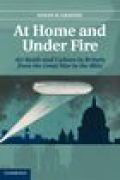
At home and under fire: air raids and culture in Britain from the great war to the Blitz
Grayzel, Susan R.
Demonstrates how the legacy of Britain's first air raids helped prepare civilians for the Second World War. This book studies British civilians' experiences of, and responses to, air raids during the First and Second World Wars. Memories of the World War I bombings shaped British response to future wars and helped redefine a gendered understanding of how civilians should respond to modern war. This book studies British civilians' experiences of, and responses to, air raids during the First and Second World Wars. Memories of the World WarI bombings shaped British response to future wars and helped redefine a gendered understanding of how civilians should respond to modern war. Although the Blitz has come to symbolize the experience of civilians under attack, Germany first launched air raids on Britain at the end of 1914 and continued them during the First World War. With the advent of air warfare, civilians far removed from traditional battle zones became a direct target of war rather than a group shielded from its impact. This is a study of how British civilians experienced and came to terms with aerial warfare during the First and Second World Wars. Memories of the World War I bombings shaped British responses to the various real and imagined war threats of the 1920s and 1930s, including the bombing of civilians during the Spanish Civil War and, ultimately, the Blitz itself. The processes by which different constituent bodies of the British nation responded to the arrival of air power reveal the particular role that gender playedin defining civilian participation in modern war. Advance praise: 'Professor Grayzel shows that in order to understand the real impact of the Blitz, it is important to go back a quarter of a century to the first aerial assault on Britain. Drawing on a vast range of sources and utilizing the theoretical sophistication of a historian at the height of her powers, At Home and Under Fire also manages to make us recognize once more the unprecedented shock of death fromabove and engages our sympathy with the people first caught under the bombs.'Dr Adrian Gregory, University of Oxford 'Throughout the twentieth century, and into the twenty-first, civilians have been the subject of aerial bombardmentas combatant nations and groups have sought to win conflicts by inflicting death and injury on those at home 'behind the lines'. In this riveting study Susan Grayzel traces the origins of this all-too-familiar form of warfare back tothe early twentieth century, showing the impact of aerial warfare on the homeand on those within. Exploring the responses to this new threat to personal and national security from the state, the media, and individuals, this is trulya book for our times.' Lucy Noakes, University of Brighton 'At Home and UnderFire is an exhaustively researched and illuminating analysis of the impact ofair warfare on Britain in the twentieth century. Grayzel thoughtfully analyzes the political and cultural responses to and consequences of the bombing in World War I, examining the policy and public debates at the time and in the war's aftermath. She clearly demonstrates how weapons from the skies used againstBritish civilians beginning in 1914 shaped interwar debates about controllingwar, protecting civilian lives, and preparing for the war to come, and how these, in turn, informed responses to the massive attacks from the air in World War II. The book significantly enriches our understanding of the nature and consequences of 'Total War'.' Sonya O. Rose, Professor Emerita, University of Michigan INDICE: 1. Modern war and the militarization of domestic life; 2. Destroying the innocent: the arrival of the air raid, 1914–1916; 3. Redefining the battlezone: responding to intensified aerial warfare, 1917–1918; 4. Writing and rewriting modern warfare: memory, representation, and the legacy of the airraid in interwar Britain; 5. Inventing civil defense: imagining and planning for the war to come; 6. Trying to prevent the war to come: efforts to remove the threat of air raids; 7. Facing the future of air power: responding to interwar air raids; 8. Preparing the public for the next war: the expansion of air raid precautions; 9. Protecting the innocent: gas masks and the domestication of air raid precautions; 10. Responding to the air war's return: the militarized domestic sphere from Munich to the Blitz; 11. Representing the new air war:morale and the domestication of the air raid in wartime popular culture; 12. Conclusion: air raids and the domestication of modern war.
- ISBN: 978-0-521-87494-6
- Editorial: Cambridge University
- Encuadernacion: Cartoné
- Páginas: 334
- Fecha Publicación: 09/01/2012
- Nº Volúmenes: 1
- Idioma: Inglés
